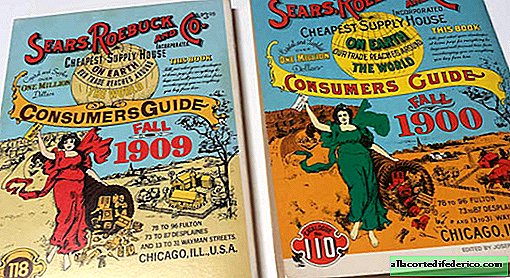The mystery of advertising tricks: in the United States ordered things by mail before the advent of computers
Today, Americans are used to the fact that almost everything can be ordered online. Amazon.com, the online megastore, has made its founder, Jeff Bezos, the richest man on Earth, and Chinese AliExpress is not far behind him. But a hundred years ago, before the invention of any computers, the Americans already ordered many products by mail. And they did it with the help of huge catalogs.

Chief among them was the Sears Roebuck catalog (Sears has existed to this day, but is not so successful, it was overshadowed by online competitors). Its founder, Richard Sears, many consider the genius of advertising, as evidenced by the stunning success of his brainchild.
In the 1880s, Sears began by reselling watches that he distributed throughout the country by mail. In those years, the United States experienced a railroad flourish and food could already be shipped to any corner - it does not matter if the recipient himself has to pick it up from the nearest railway station. (It’s a pity that since then only rare hints have remained of American love for trains!)
By the end of the 19th century, Sears (and his partner Robak) sold a wide variety of items through huge catalogs that were printed twice a year. The first catalogs were positioned as price guides that anyone could order their home for free, just to see the “fair price” for a particular product. Of course, upon receiving the catalog, the Americans realized that ordering things from it was much cheaper than buying them at local stores.
A variety of catalogs struck the imagination of the country, the majority of whose citizens still lived away from cities. The pages of these thick books suggested that they purchase everything from musical instruments and agricultural implements to weapons and furniture.

And starting in 1908, Sears catalogs began to sell entire homes! Housing was delivered in huge containers and consisted of finished building materials and drawings. The company promised that a man, even without the experience of a carpenter, would be able to assemble such a house according to instructions in three months. The instruction contained detailed drawings of rooms with notes where you can put what kind of furniture (which, of course, had to be ordered separately).

At the beginning of the 20th century, the Sears catalog could be found in one of three American homes. Its main competitor in those years was Montgomery Ward, a similar catalog of all sorts of things, which also came for free to many families.
There is a legend that Richard Sears, being, as I said, a genius in marketing issues, went on a trick to outrun competitors. He ordered the format of his catalog to be a little smaller than the Montgomery Ward catalog. Almost the same, but a little shorter and narrower.
What do you think he did it for?
Answer:
The answer is surprisingly simple and elegant.
Sears imagined an average American family, in which, most likely, along with the catalog of his company will be the publication of competitors, Montgomery Ward. And in the house there is always a diligent housewife who, sorting mail, magazines and books, will put them in a neat pile. Or rather, in the pyramid.
Larger editions will appear below, and those smaller (for example, the catalog of the Sears company) will lie on top.
So, when the owner reaches for the catalog, he is much more likely to take the Sears catalog at the top of the pyramid.

















